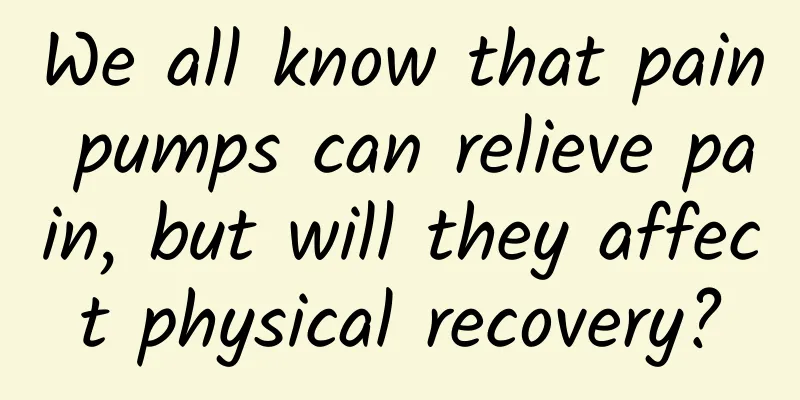We all know that pain pumps can relieve pain, but will they affect physical recovery?

|
Author: Bao Rong and Gao Xinyue, Department of Anesthesiology, Pudong New District Punan Hospital, Shanghai As patients' demand for comfort medical care increases, the use of pain pumps continues to increase. However, many patients still have many concerns about the use of pain pumps. The most common question is whether the pain pump has side effects? Will it affect physical recovery? Let's listen to the explanation of anesthesia experts. 1. First, let’s listen to the expert explain the working principle of the pain pump? Analgesia pump is an automatic micro-infusion device used for pain treatment. It continuously pumps analgesics to maintain a stable blood concentration of the drug in the blood to achieve the purpose of analgesia. Currently, the widely used analgesia pumps are divided into mechanical pumps and electronic pumps. Patients can add additional medication by themselves through the self-controlled analgesia button according to the pain situation, achieving the purpose of individualized, low-dose, and efficient analgesia. Listen to experts explain why we need analgesia pumps? When talking about analgesia pumps, we need to understand postoperative pain and its effects. Postoperative pain refers to acute pain that occurs immediately after surgery. It is common in long or traumatic surgeries such as chest and abdominal surgeries and orthopedic surgeries. It causes a series of adverse effects on the body from a physiological, psychological and behavioral perspective, such as: 1. Increase the body's oxygen consumption. 2. Impact on cardiovascular function: The heart rate increases, the heart load increases, and the risk of myocardial ischemia and myocardial infarction in patients with coronary heart disease increases. 3. Impact on respiratory function: Pain causes rapid and shallow breathing, stiff respiratory muscles, inability to cough forcefully, and inability to clear respiratory secretions, leading to complications such as atelectasis and lung infection. 4. Effect on gastrointestinal motility: leads to reduced gastrointestinal motility and delayed recovery of gastrointestinal function. 5. Impact on urinary system function: The motility of urethra and bladder muscles is weakened, causing urine retention. 6. Effects on bones, muscles and peripheral blood vessels: increased muscle tension, muscle spasms, and restricted body activities; increased risk of deep vein thrombosis and even pulmonary embolism. 7. Impact on neuroendocrine and immunity: Inflammatory response occurs and immunity decreases. 8. Impact on psychological and emotional aspects: It can cause anxiety, fear, and depression. 9. Sleep disorders. This shows how harmful pain is and how necessary it is to control pain. This is why patients are advised to use an analgesic pump. Listen to the experts' explanation of why patients are recommended to use analgesia pumps? 1. Patients have analgesia needs: Pain refers to a person's unpleasant subjective feeling and emotional experience of noxious stimulation. Therefore, patients who are afraid of postoperative pain before surgery or have a low pain threshold can use it. 2. Surgical site and size: It is recommended for large and medium-sized chest, abdominal and orthopedic surgeries, where postoperative pain is the most severe. 3. Postoperative rehabilitation needs: It can prevent adverse stress reactions and cardiovascular events caused by local muscle spasms caused by postoperative pain. 4. Listen to the experts explain whether the pain pump will affect the patient's postoperative recovery? 1. Analgesia pump helps promote the healing of surgical incisions Postoperative wound healing is actually a special inflammatory process of tissue repair. The main factors affecting wound healing are: infection, foreign body residue, blood circulation disorders, and poor general condition of the patient, such as diabetes, malnutrition, excessive obesity, and low immunity. The analgesic pump continuously delivers analgesics through the vein or epidural space to relieve the patient's postoperative pain and surgical stress response, reduce the body's stress response and the release of inflammatory factors, help inhibit sympathetic nerve excitement, dilate blood vessels, improve local blood supply and oxygen supply, and promote wound healing. 2. Impact of common adverse reactions of analgesia pumps on postoperative recovery Everything has two sides. The use of analgesic pumps can also cause adverse reactions, the most common of which is nausea and vomiting, but this cannot be entirely blamed on the analgesic pump itself. In fact, it is related to three factors: ① Patient factors: women, motion sickness, and non-smokers are high-risk groups for postoperative nausea and vomiting; ② Anesthetic factors: opioids and inhaled anesthetics are susceptible factors; ③ Surgery factors: Long-term surgery, laparoscopy, open surgery, neurosurgery, etc. have a higher chance of occurrence. Other adverse reactions include respiratory depression, intestinal motility inhibition, drowsiness, urinary retention, etc. These side effects are generally relieved when the analgesic pump is stopped. Compared with the damage to the patient's body caused by pain, the benefits of using an analgesic pump after surgery far outweigh the disadvantages. 5. Finally, listen to the expert’s explanation on why the use of a pain pump cannot be completely painless? The pain pump can relieve pain to a great extent, but it is not completely painless. As the saying goes, "blessings often go hand in hand with disasters." When patients enjoy good pain relief effects, if they excessively pursue painlessness, they will inevitably increase the dosage of analgesics in the pump, then related adverse reactions such as respiratory depression and drowsiness will follow, which will be detrimental to physical recovery. Have you resolved your doubts after this introduction? The use of analgesia pumps can relieve postoperative pain and reduce surgical stress reactions on the one hand, and promote postoperative recovery and ensure comfortable medical treatment on the other hand. Why not? Finally, a reminder that the use of analgesia pumps should be under the guidance of an anesthesiologist. |
<<: Doctors remind you: Don't do liposuction, it's a waste of money and useless
>>: Why doesn't Clivia like to grow? How often should I water Clivia?
Recommend
How to take Letrozole to stimulate ovulation
According to statistics, the incidence rate of in...
How to treat second degree cervical erosion
Cervical erosion is a very common gynecological d...
How is Chuzhimei collagen? Evaluation of Chuzhimei collagen
Collagen is as important to me as fruits and enzy...
Why does confinement last 42 days?
The confinement period for women is a very critic...
Urgent reminder! Don’t do these 10 things in summer, otherwise you will be sick
This article was reviewed by Pa Li Ze, chief phys...
What to do if a girl has a bad temper
A bad temper can have a great impact on a person&...
What are the symptoms of multiple uterine cysts?
Some women go to the hospital for a check-up beca...
After the age of 50, eating more carbohydrates can reduce mortality! A special reminder: Don’t eat with a spoon…
This article was reviewed by Zhang Zhaomin, Maste...
Blastocyst implantation symptoms
The blastocyst can be said to be an embryo, and t...
Can I take medicine for fungus during menstruation?
Menstruation is something that a woman must exper...
How to put on makeup for girls wearing glasses
With the development of technology, mobile phones...
What is low-grade cervical squamous intraepithelial lesion?
For the sake of their own health, women pay speci...
Will I have stomach pain during the first few days of pregnancy?
Stomach pain will make pregnant women feel very u...
Eczema: The causes and secrets of fighting rash
Author: Mao Chong Sichuan Provincial People's...
Can pregnancy be detected 2 days after menstruation?
When women suspect they are pregnant, they usuall...









